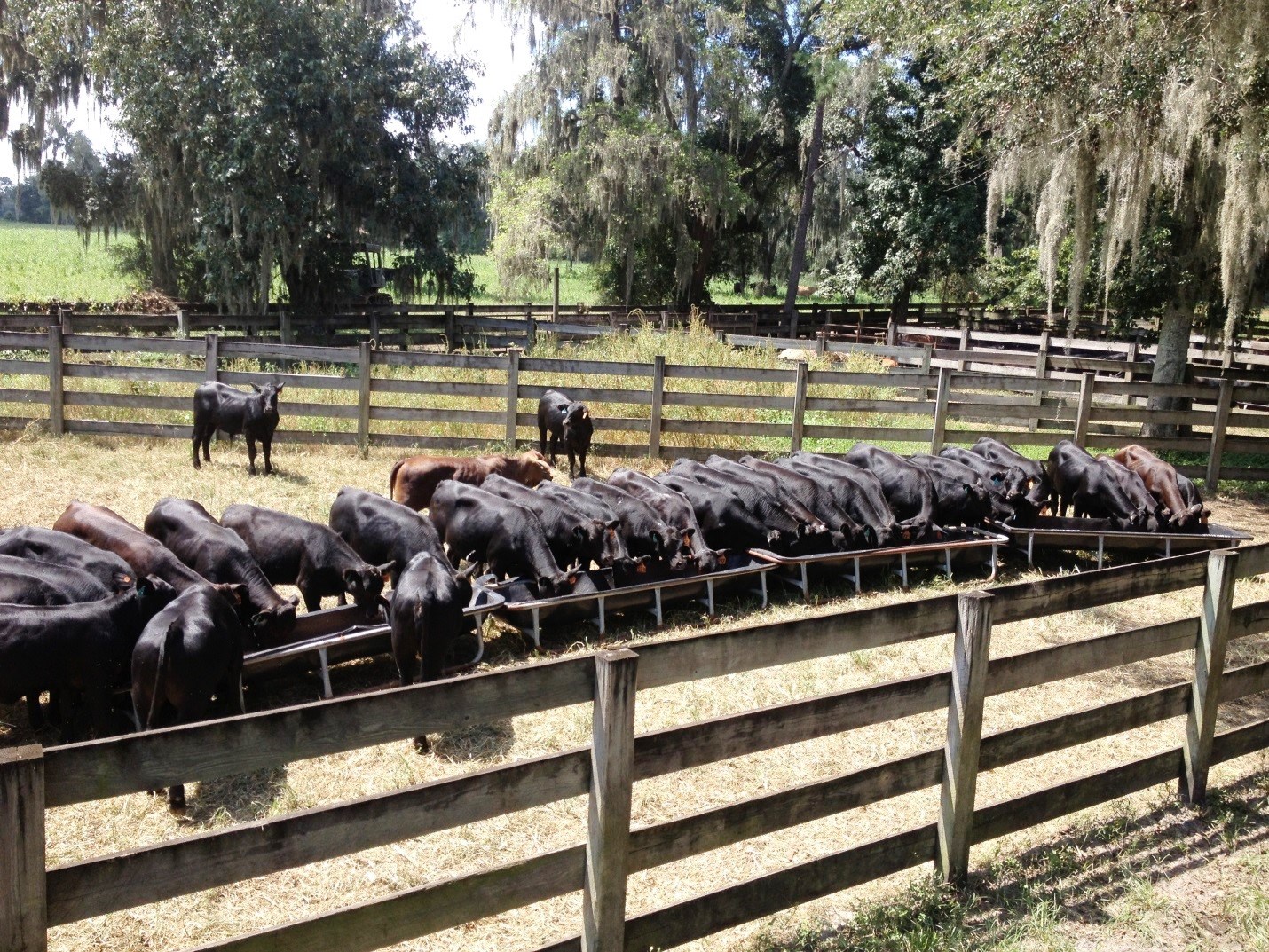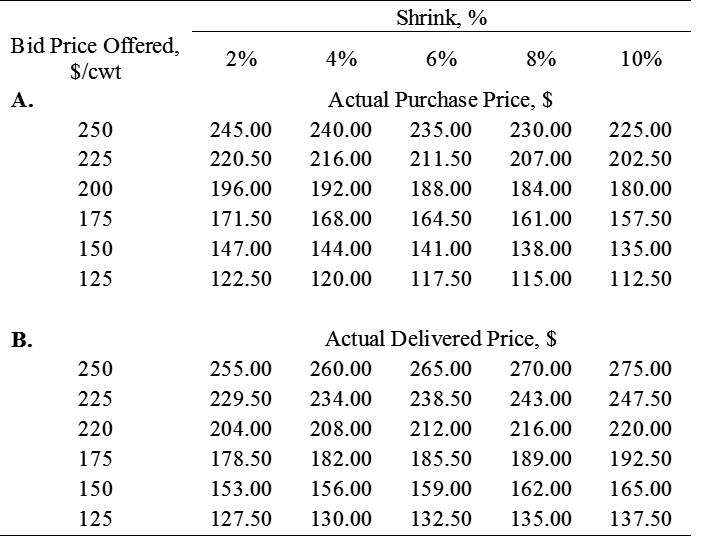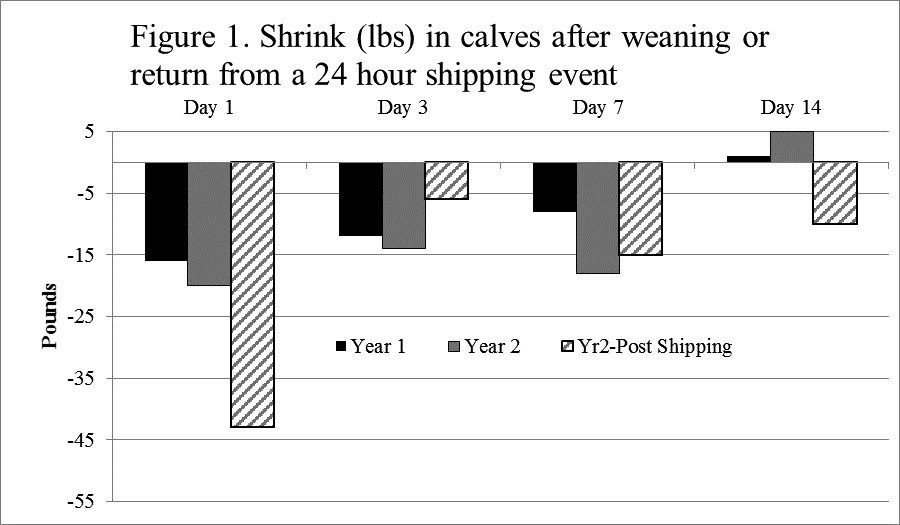
Calves after weaning can undergo a considerable amount of shrink in bodyweight as a result of stress and diet changes. Photo by Matt Hersom (Alachua, Florida)
Shrink in beef calves constitutes a potential economic loss to both the seller and the buyer if not fully considered. A number of factors cause shrink, but primarily feed and water deprivation or lack of consumption and exposure to stress have the greatest magnitude. Shrink in beef cattle is the loss of weight as a result of gut fill or tissue loss from the animal.
How Does Shrink Occur?
Shrink occurs when the weight at one location is less than the subsequent weight at another location. Shrink occurs from the pasture to the working facilities, the pasture to the sale barn, or the ranch to the feedlot. Those examples demonstrate the impact of handling stress, travel, time, and food/water deprivation on shrink. The amount of shrink increases with increasing number of stressors and duration of the stressors. Figure 1 shows the amount of body weight lost from calves at weaning; also presented is the shrink experienced after 24-h shipping event subsequent to a 45-day backgrounding. After weaning, the amount of shrink in one day amounted to 3.5 to 3.9%, similar to the amount of shrink after 8-hours of standing in a drylot. Calves did not regain their off-pasture weaning weight until 14 days after weaning even though these calves were offered high-quality large round bale hay and a pelleted supplement at 0.5% of their weaning weight. So not only was the shrink associated with a change in diet, but with handling, change in environment, and loss of tissue from stress.
Factors Affecting Shrink
Transportation time. The amount of time a calf spends in transit on a trailer is one of the largest factors affecting the amount of shrink experienced. Generally, most of the shrink occurs early on in the shipping event. Studies have demonstrated that calves will shrink about 1% per hour for the first 3 to 4 hours, then ¼% for the next 8 to 10 hours. Many calves leaving Florida and the Gulf Coast Region can experience a 24 hour shipping event to reach their next destination in the Southern Plains or Texas.
Amount of fill. The diet that cattle are consuming can affect the amount of fill and subsequent shrink experienced. Diets low in dry matter and high in moisture result in a greater amount of shrink experience, whereas dryer diets create less shrink. Cattle that are exceptionally full will shrink a great deal; cattle buyers are aware of this and will discount the price offered for overly full cattle. Cattle that shrink 10-12% undergo a greater amount of stress which makes them more susceptible to sickness and poor performance.
Condition/Weight. Cattle that are fatter tend to shrink less than cattle that have less body fat. Fat contains less water than lean muscle tissue so less metabolic-tissue water is loss to shrink. There is a relationship between body weight and fat content, but it is not always strong. Cattle of similar body weight, but different body compositions will have different shrink responses.
Season. Higher temperatures induce a greater stress response in cattle and thus a greater shrink response. When temperatures are high, cattle lose more metabolic water through heavy breathing and greater maintenance energy expenditure than during cool temperatures. Likewise, the diet composition and fill associated with diet is affected by season.
Handling procedures. Cattle shrink less when they are handled in a quite manner using good Beef Quality Assurance handling practices. Likewise, the amount of shrink is minimized when cattle are shipped directly from the ranch of origin to their final destination. Congregation and co-mingling cattle for sorting and re-shipping ads increases stress and add shrink to cattle.
Calf Price and Shrink
Table 1-A considers the relationship between the bid prices offered on cattle, the shrink allowed in the negotiation by the buyer, and the actual purchase price of the cattle. Instead of the buyer purchasing the cattle on a delivered basis, the buyer may offer a price with a declared pencil shrink percent. For example a buyer may offer an owner $200/cwt with a 4% pencil shrink, from Table 1A then, the actual purchase price is $192/cwt for the cattle. Alternatively, a buyer may have bought cattle for $225/cwt, but if the cattle actually experienced an 8% shrink, then the buyer’s cost for cattle was actually $243/cwt (Table 1B). The amount of shrink increases the actual cost of the transaction.
Take Home Message
Shrink in cattle occurs often with detrimental economic impacts. The cattle owner can mitigate some causes for shrink at the ranch of origin, through timing of marketing, and animal handling techniques. Not considering shrink and the potential outcomes during the marketing process jeopardizes the optimum price point for both the buyer and seller.

Table 1. Relationship of Calf Bid Price and Allowed Pencil Shrink on Price (A) or Calf Bid Price, Actual Shrink, and Actual Delivered Price (B).
For more information on this topic, please see the following UF/IFAS publication: Factors that Affect Calf Selling Price at Marketing
- Clemson Virtual Southeast Cow-Calf Conference – November 11-12 - November 6, 2020
- Dispelling Cattle Mineral Supplementation Myths - November 15, 2019
- What Influences Profit for the Beef Cattle Enterprise? - June 3, 2019

